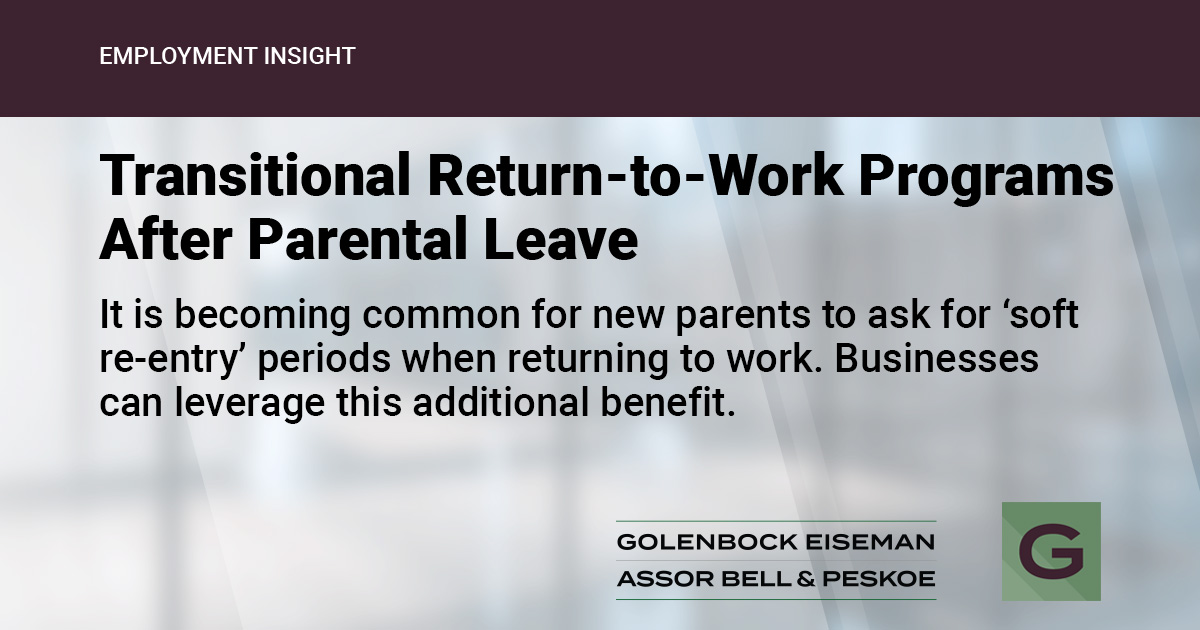Transitional Return-to-Work programs have been a part of the employment-law lexicon for decades. Traditionally, these programs have arisen in the context of post-disability reentry. This would be the so called “light duty” assignment. The idea is to better enable a valuable employee to come back to the workplace sooner than they otherwise could have without the program. This is normally accomplished by accommodating an altered work arrangement inside the organization. Work-from-home arrangements are a common permutation. These programs also have side benefits, such as promoting company-employee connection and reducing turnover. Of course, employees tend to like the flexibility as well. As a result, these programs are not rare creatures.
It is only natural to apply such a well-worn concept to a hot topic like parental leave. Whether or not, “parental reentry benefits” becomes the next flavor-of-the-month (in the employee benefits realm) remains to be seen. However, it can be argued that Transitional Return to Work is already a de facto perk in many professional services settings. It is much more common these days for professionals to ask for such transition periods when returning from parental leave than it used to be, such as asking for three remote (or partial) days at the start of their return.
Employers who want to promote a positive work environment tend to provide some form of this flexibility. One could easily argue that it is better for employers to simply get ahead of the curve and expressly advertise such “parental reentry benefit” offerings, leveraging any resulting goodwill, and also put some guardrails around it to avoid misuse. Many employers will allow at least some form of soft reentry to the workplace anyway. A “parental reentry benefit” can also complement other targeted leave offerings that are often meant to improve recruitment efforts, such as leave benefits for in vitro fertilization procedures, upon miscarriage, and/or traditional paid parental leave itself.
The “parental reentry benefit” may be the next big thing in employee retention.
###
This article was written by Alexander Leonard, Partner and Chair of the Labor & Employment group, Golenbock Eiseman Assor Bell & Peskoe LLP.
Golenbock Eiseman Assor Bell & Peskoe LLP
Golenbock Eiseman Assor Bell & Peskoe LLP is a full-service Manhattan-based business law firm of approximately 60 attorneys which has served its clients’ complex litigation, corporate, labor & employment, reorganization, intellectual property, real estate, tax, and trust & estate needs for 40 years. The firm takes pride in its sophistication, experience, and ability to take on major engagements for its domestic and international clients while also maintaining a hands-on, personalized approach to all matters.
The firm represents entrepreneurial, portfolio, and institutional clients, ranging from start-ups to Fortune 500 companies, with a specific focus on the mid-market segment. Corporate clients include middle-market private corporations, public companies, private equity firms, venture capital firms, individual investors, and entrepreneurs on a global scale.
Golenbock is a member of the Alliott Global Alliance, which was named to Ba1 of global law firm alliances by Chambers Guides, the prestigious international legal survey. Alliott numbers 215 firms in 94 countries on six continents, and helps member firms partner with others in countries around the globe.
